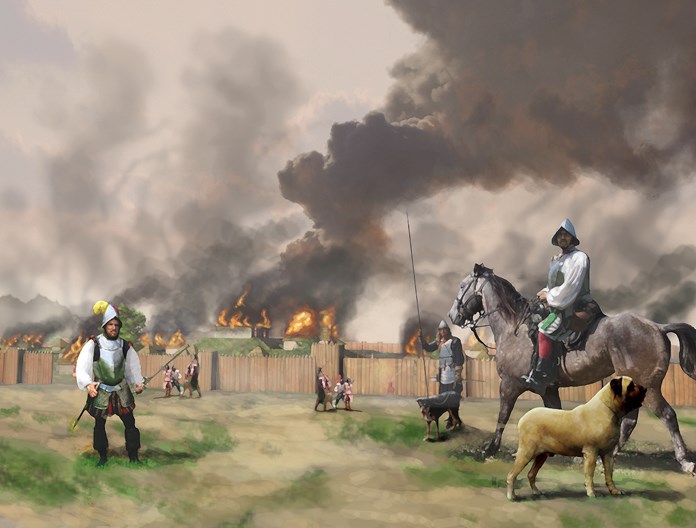by: Caleb Curren
Contact Archeology (CAI)
Archeology Ink.com
A Research and Education Online Journal
September 2022
The famous battle site of 1540 between the armies of Hernando de Soto and Native Mabilians was fought in present-day southern Alabama. The archeological site of the battle is not known. The story of the battle is well known through writings of Spaniards who participated in the day-long conflict and is pivotal to our understanding of both the cultures of the Spanish and Natives of the 1500s. Thousands of men and women died in the battle. Their story should be told.
Two research groups are searching for the battle site. Members of our group, Contact Archeology Inc. (CAI), have been testing hypotheses for decades and have amassed an unprecedented archeological database relative to the subject. The geographic region of the research extends from the rivers of the Alabama, Warrior, and Tombigbee to the Gulf Coast. The research has determined that the Mobilians of the time of the Soto Expedition were likely located in southwest Alabama and are represented by the late Bottle Creek and Bear Point archeological phases. Another group, the University of West Alabama (UWA), has recently claimed that the battle site of Mabila is further north in Marengo County, Alabama. Dr. Ashley Dumas of UWA has stated that:
“We are now certain that we have the province of Mabila …While the exact site of the battle still hasn’t been located … it probably happened within a few miles of the territory …”
(Alabama Newscenter Nov. 14, 2021)“I think we are within several miles of the battle site.”
(Alabama Newscenter December 3, 2021).“It’s one of those rare, TV moments … It doesn’t happen this way. It was a remarkable moment in archaeology, a remarkable moment for me.” (Alabama Newscenter December 3, 2021).

The UWA archeologists working in Marengo County have indeed found 16th-Century Spanish artifacts. That in itself is certainly important data, however, there are a number of ways to interpret those data without prematurely leaping to the conclusion that the Mabila Chiefdom and battle site of Mabila are located in Marengo County.
No features such as fire hearths, refuse pits, Spanish burials, or Spanish structures or the battle site itself have been identified in Marengo County. Even the Native ceramic assemblages from the Marengo County sites tend to indicate a post-Soto time period.
The Spanish artifacts found in Marengo County could have come from Native salvaging after the battle of Chicasa on the west side of the Tombigbee River between the Soto army and the Natives or even from Native/ Spanish trade with the 1559 Luna Expedition traveling to the Native Coosa Chiefdom in northeast Alabama long after the Soto Expedition of 1540.

We must rely heavily on the writings of the Spanish participants of the Soto Expedition. The UWA conclusions do not match the writings of those expedition chroniclers.
The Soto Expedition was moving south toward the Gulf Coast to rendezvous with their fleet of ships for resupply. Why would they proceed west into Marengo County when their resupply fleet was on the coast to the south? Recently, a member of the UWA research team, Dr. James Knight has proposed a much more reasonable scientific approach to the discoveries of 16th-Century Spanish artifacts in Marengo County. Knight has stated:
“It’s also confusing … because without more study and exploration, the (UWA) team can’t say for sure how all this Spanish metal got to where it is. Was it left here by the (Soto) Spanish, or carried here later from some other place by the natives? … it’s also not clear yet the exact time when these native farmsteads were settled. Was it immediately after the battle of Mabila—with the conflict driving the local people to spread out from the burned town—or was it decades later?” (Alabama Newspaper, July 19, 2022).
It is certainly understandable that Dumas has become overzealous in claiming the Mabila chiefdom in Marengo County and made presumptive conclusions too soon. Other researchers have also made that mistake regarding early Spanish contact projections. The excitement of discovery can sometimes cloud one’s reason regarding interpretation of the data as in the attempts by a variety of researchers to claim the location of the Mabila Chiefdom in parts of Alabama as well as the location of the Luna Colony on Pensacola Bay and the interior Luna settlement of Santa Cruz de Nanipacana in Alabama which have proven over time to be lacking in definitive archeological data.
To locate the battle site of Mabila is, after all, a lynchpin in our understanding of the initial contacts of European cultures with Native cultures. Knight has injected the voice of reason amidst the emotional chaos concerning the UWA Marengo County claim. He has set the course for further research in the area. Hopefully, his colleagues will heed his sage direction.
CAI encourages UWA to continue their research as we are continuing our research in the “Forks” region of S.W. Alabama, an accepted location of a portion of the huge Chiefdom of Mabila and an excellent candidate for the location of the battle site of Mabila in southern Clarke County.
Archeological research is a complicated course of defining the mysteries and developing hypotheses for solving those mysteries. Social media and news reports cannot resolve the issues. It takes slow, deliberate attention to data detail, peer review of hypotheses, and time to solve the riddle of the location of the battle of Mabila.